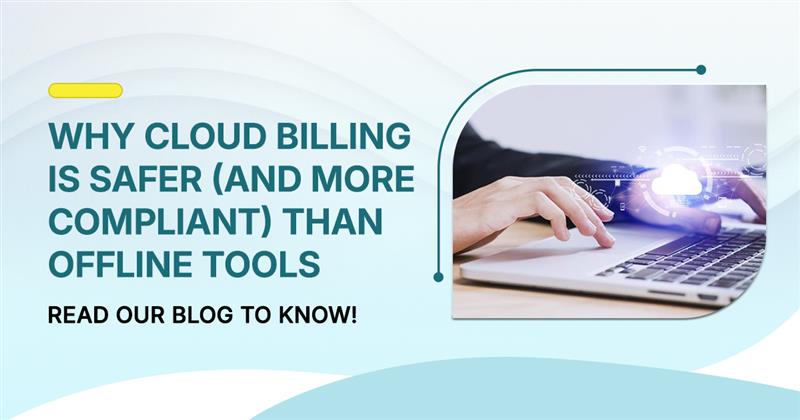Table of Contents1. Introduction 2. Understanding the Risks of Offline Billing Tools 3. How Cloud Billing Enhances Security 4.Best Practices for Migrating from Offline to Cloud Billing 5. Conclusion |
|
Introduction
Managing billing is one of the most important parts of any business. Mistakes or data breaches in billing can cost you money and even legal trouble. Many businesses still rely on offline tools like excel sheets or desktop software. While these might feel used to but they carry hidden risks. The smarter and safer choice today is to use cloud billing solutions as they are built to protect your data and keep you compliant. In this blog, we’ll break down the risks of offline billing and explain how the cloud keeps you safe and share a clear plan to migrate without stress.
Understanding the Risks of Offline Billing Tools
Offline billing tools store everything locally which means your data is on one machine or in one office. This can be risky for several reasons:
-
➤No real-time backup: If your system crashes, your data could be lost forever.
-
➤Higher chance of human error: Manual data entry often leads to costly mistakes.
-
➤Weak security: Offline systems can’t match the encryption and safeguards of secure cloud billing.
-
➤Limited compliance tracking: Offline tools don’t automatically meet compliance in cloud billing standards which can lead to penalties.
-
➤Version conflicts: Sharing files over email often creates confusion over which version is correct.
-
➤Physical vulnerability: Theft, fire or natural disasters can destroy all your billing records.
How Cloud Billing Improves Security
Moving to a cloud-based billing system isn’t just about making billing faster, it's about protecting your business data from theft, loss or misuse. Here’s how cloud billing keeps you safe:
-
1. Advanced encryption – Every piece of data is scrambled into unreadable code while stored or sent over the internet. Even if hackers intercept it, they can’t understand it without the encryption key.
-
2. Multi-factor authentication – Instead of just using a password (which can be stolen), you also need a one-time code or fingerprint to log in. This makes it much harder for unauthorized people to access your billing data.
-
3. Automatic backups – Your data is saved automatically in multiple secure locations. If your system crashes or files get deleted by mistake you can restore everything instantly.
-
4. Real-time updates – The system receives security fixes the moment they’re released. Offline tools require manual updates which leave you at risk in the meantime.
-
5. Access control – You decide who in your company can view, edit or download billing data. This keeps sensitive financial information limited to the right people and improves data security in cloud billing.
-
6. Disaster recovery – If a natural disaster, fire or server breakdown occurs, your billing data is still safe because it’s stored in multiple protected data centers.
-
7. Remote access with safety checks – One of the biggest online billing advantages is that you can log in from anywhere but with extra protections like IP restrictions and activity monitoring to prevent suspicious logins.
Best Practices for Migrating from Offline to Cloud Billing
Switching to the cloud is easier if you follow a structured approach. Here are some practical steps:
-
➤Assess your current process – Start by identifying gaps and pain points in your offline billing system.
-
➤Choose a trusted provider – Select cloud billing software with strong security and compliance features.
-
➤Verify regulatory fit – Ensure it meets regulatory compliance cloud billing requirements in your region or laws.
-
➤Train your team – Provide hands-on training before fully transferring to the online system.
-
➤Start small – Migrate a small batch of invoices first to test the system.
-
➤Back up old data – Keep a secure copy of past billing records.
-
➤Automate repetitive tasks – Take advantage of cloud billing automation to save time and reduce errors.
-
➤Monitor and review – Regularly check performance and security settings of your system.
Conclusion
Offline billing tools may feel familiar but they carry hidden risks that can put your business at risk. By adopting cloud billing solutions, you can protect sensitive information, ensure compliance and make your billing process more efficient. From encryption to automation the cloud billing offers modern safeguards that offline tools simply can’t match. In today’s digital-first world it is important to know that securing your billing system isn’t a luxury, it's a necessity.
